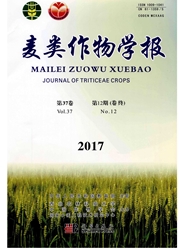

 中文摘要:
中文摘要:
miR398是受逆境胁迫负调控的miRNA,其靶基因CSD编码超氧化物歧化酶(SOD),使植物抵御活性氧(ROS)的毒害。为进一步了解低温胁迫下miR398的调控机制,从东农冬麦1号中克隆小麦miR398前体,构建过表达栽体并转化拟南芥,用Real-timePCR检测T0代植株中小麦miR398及其靶基因CSD1在低温胁迫下的表达量。结果表明,随着低温胁迫时间的延长,miR398表达下调、CSD1基因表达上调,认为小麦m艉39占能响应低温胁迫、负调控CSD1基因表达,间接提高了拟南芥的抗寒性。
 英文摘要:
英文摘要:
miR398 is a miRNA that is negatively regulated by the adversity. The target gene CSD en- coding superoxide dismutase (SOD) can resist the toxicity of ROS in plants. In order to further under- stand the regulatory mechanism of miR398 under low temperature stress, the wheat miR398 precursor gene was cloned from Dongnongdongmai 1,and overexpression vector was conducted and transformed into Arabidopsis thaliana ,and Real-time PCR was used to detect the expression level of miR398 and its target gene CSDJ in To generation under cold stress. The results showed that miR398 of wheat re- sponded to cold stress and down-regulated the expression of CSD1 in Arabidopsis. With the extension of low temperature stress time, the expression of miR398 was down-regulated and the expression of CSD1 was up-regulated. It was suggested that the wheat miR398 could respond to low temperature stress and negatively regulate CSD1 gene expression,which indirectly enhanced the cold resistance of Arabidopsis thaliana.
 同期刊论文项目
同期刊论文项目
 同项目期刊论文
同项目期刊论文
 期刊信息
期刊信息
